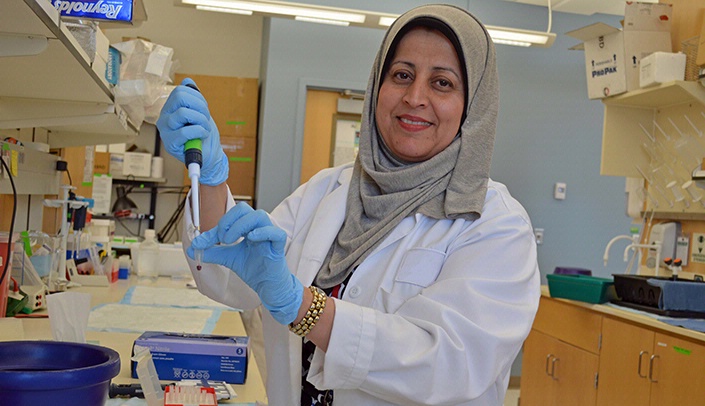Dr. Deegan’s Research Looks to Prevent Treatment’s Side Effects
Before she earned her Ph.D., and before she came to UNMC as an assistant professor in the College of Allied Health Professions, Dr. Iman Ahmad worked about 10 years as a radiologic technologist. It was demanding work, made more so by the work ethic she shared with many radiologic techs – she put the patient before herself.
“I was young and crazy and wanted to work hard,” Dr. Ahmad recalled. It never occurred to her how much radiation she, herself, might be taking on. She admits that she did not always follow best practices – for example, she would hold a child patient, in order to make the radiographic position go better, putting herself within the primary beam.
“I forgot about myself,” Dr. Ahmad said. And research shows that despite their own workplace rules, education and better judgment, some radiologic techs do the same.
But now, Dr. Ahmad is an educator and researcher. Her specialty is measuring redox status – that is, the increase or decrease, within our bodies, of oxidative stress. It’s a sought after skill, and she is grateful to collaborate on a handful of research projects across campus.
But one close to her heart is a pilot study analyzing the redox status of those who serve in her old job – radiologic techs.
They remain dedicated to their patients. But Dr. Ahmad wants to help ensure the safety of those who are “occupationally exposed” to radiation.
“We are not scaring them,” she said. “This is about awareness.”
Even those who follow best practices to the letter, if they work double shifts and don’t take vacations, may be exposed to too much radiation. “Those doses will accumulate in your body,” Dr. Ahmad said.
Dr. Ahmad looks at whether the techs’ redox levels are able to remain in balance, or tip too far into oxidative stress.
A number of factors may come into play, and a follow-up study will delve into whether lifestyle and work habits make a difference, how DNA damage is sustained and how other biomarkers can be identified.
Her pilot study, with a small number of Nebraska Medicine volunteers as subjects, found evidence that exposure to radiation within limits recommended by the International Commission of Radiation Protection (ICRP) in procedures with higher doses of radiation – CT scans and interventional radiography
(IR), for example – have an altered circulating redox balance as compared to conventional radiography and unexposed individuals.
Dr. Ahmad stresses that the low doses of radiation to which radiologic techs are exposed to is generally not high enough to cause direct damage, but the concern is their long-term effects, which are more worrisome as they include cancer and genetic risk.
“We can take it one step back,” she said.
“If we do what we have to keep our redox levels in balance, we will be safe.”
Rebecca Oberley Deegan, Ph.D.
Dr. Deegan’s Research Looks to Prevent Treatment’s Side Effects
Radiation kills cancer cells. But radiation also produces free radicals, which cause inflammation, which drives more free radical production, which can damage normal tissues and sometimes leave lasting effects.
“Some patients end up with long-term side effects that never go away,” said Rebecca Oberley Deegan, Ph.D. “Their life is probably diminished because of this.”
But Dr. Deegan, assistant professor of biochemistry and molecular biology, works with a compound that acts as a scavenger of free radicals and has the potential to protect normal tissue from radiation damage.
Dr. Deegan’s UNMC lab is collaborating on the project with Duke University and the University of Colorado. Results in animal models have been encouraging – and investigators hope to take the study to human clinical trials in about a year.
UNMC would be in charge of trials for patients undergoing radiation therapy for head and neck cancer, Dr. Deegan said. The investigators also are exploring the compound’s potential for treating other cancers.
Superoxide dismutase (SOD) is a naturally occurring enzyme within the human body, first discovered in the 1960s. Scientists picked up on its abilities to scavenge free radicals, and throughout the 1980s and 90s tried to find ways to use it to fight the aftereffects of radiation therapy. But they found the protein had a short half-life in tissues, rendering it ineffective as a therapeutic.
The lab at Colorado, where Dr. Deegan previously worked as a junior scientist, worked with chemists at Duke to develop a better version of SOD – a synthetic with all the benefits, but not all the complications of administering a purified protein.
“It’s a very small molecular-weight drug,” Dr. Deegan said. “Smaller than an amino acid – it doesn’t cause immune response, has a long half-life and is absorbed into cells.”
Patients would get an injection before starting radiation, then every few days after.
The synthetic SOD is now being produced in larger quantities by a commercial laboratory. The collaborators hope to forge an academic-corporate partnership to further the research and help bring the product from the lab bench to the marketplace.
“We want to bring it to the point where big pharma can take it over,” Dr. Deegan said.
Dr. Deegan said clinical trials could be just around the corner. If successful, the project could lead to a big improvement in cancer-patient care.
